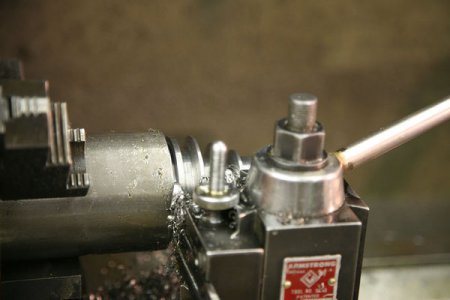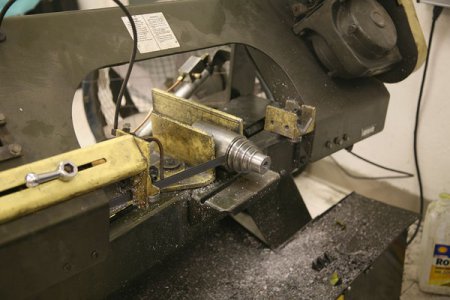- Joined
- Sep 22, 2010
- Messages
- 7,223
Hey Guys,
What can you do to prevent breaking bits while parting off?
I have seen these suggestions:
- tool dead on center. Cutoff tool need to be exactly 90 deg to the work or it will bind the tool.
- tool as thin as possible (minimum length of cutter edge engaged in workpiece)
- correct cutting fluid (NOT a lubricant, must a be cutting fluid), use cutting oil to reduce friction and galling (sticking metal)
- correct speed and feed
- setup as rigid as possible.
- quick change toolpost rather than williams holder/lantern toolpost
- minimum extension of workpiece from chuck or collet
- gibs on machine snugged down
- carriage locked down during cut"
- Use a live center.
- American HSS parting blades like those made by Empire work better than the China made ones. http://www.micro100.com/inch/t_v_blades_brazed.html
- A nick in the center of the top of the blade will cause the chip to curl up on the sides, there by lessening the chance for it to become caught between the side of the blade and the work.
- Parting blades need to be sharpened when they are new from the factory and every so often when you are using them.
- Parting on a bigger lathe is easier
- when parting try to start at the highest speed for the size of the work and try to feed more slowly as you get towards the center.
- minimum front clearance
- power feed at it's slowest setting, if you have the feed and speed right, parting with the cross feed under power is better than by hand.
- do not have the tool stick out too much.
- after cutting depth of 2x width of blade, back out move over 0.010" and continue cut deeper. keep moving over left and right sides of cut wider so a 0.093" wide blade is in a 0.103" or wider groove.
[video=youtube;82LtUTBmxwQ]http://www.youtube.com/watch?v=82LtUTBmxwQ[/video]
[video=youtube;w0N6K9y2i2M]http://www.youtube.com/watch?v=w0N6K9y2i2M[/video]
[video=youtube;PgS5GFQXSQo]http://www.youtube.com/watch?v=PgS5GFQXSQo[/video]
Do you guys have any other suggestions for success parting off?
Thanks,
Nelson
What can you do to prevent breaking bits while parting off?
I have seen these suggestions:
- tool dead on center. Cutoff tool need to be exactly 90 deg to the work or it will bind the tool.
- tool as thin as possible (minimum length of cutter edge engaged in workpiece)
- correct cutting fluid (NOT a lubricant, must a be cutting fluid), use cutting oil to reduce friction and galling (sticking metal)
- correct speed and feed
- setup as rigid as possible.
- quick change toolpost rather than williams holder/lantern toolpost
- minimum extension of workpiece from chuck or collet
- gibs on machine snugged down
- carriage locked down during cut"
- Use a live center.
- American HSS parting blades like those made by Empire work better than the China made ones. http://www.micro100.com/inch/t_v_blades_brazed.html
- A nick in the center of the top of the blade will cause the chip to curl up on the sides, there by lessening the chance for it to become caught between the side of the blade and the work.
- Parting blades need to be sharpened when they are new from the factory and every so often when you are using them.
- Parting on a bigger lathe is easier
- when parting try to start at the highest speed for the size of the work and try to feed more slowly as you get towards the center.
- minimum front clearance
- power feed at it's slowest setting, if you have the feed and speed right, parting with the cross feed under power is better than by hand.
- do not have the tool stick out too much.
- after cutting depth of 2x width of blade, back out move over 0.010" and continue cut deeper. keep moving over left and right sides of cut wider so a 0.093" wide blade is in a 0.103" or wider groove.
[video=youtube;82LtUTBmxwQ]http://www.youtube.com/watch?v=82LtUTBmxwQ[/video]
[video=youtube;w0N6K9y2i2M]http://www.youtube.com/watch?v=w0N6K9y2i2M[/video]
[video=youtube;PgS5GFQXSQo]http://www.youtube.com/watch?v=PgS5GFQXSQo[/video]
Do you guys have any other suggestions for success parting off?
Thanks,
Nelson
Last edited by a moderator:



